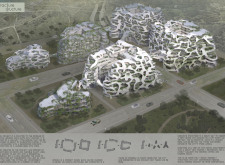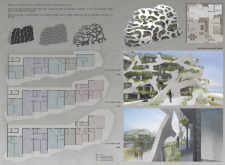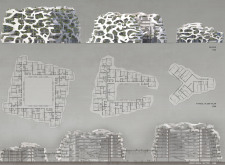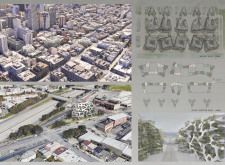5 key facts about this project
The project features a series of gallery-type modules that can be rearranged based on varying housing demands. This modularity allows for an efficient response to changes in urban density and community growth. Each unit is designed with an emphasis on openness and connectivity, utilizing large glass facades to enhance natural light and provide residents with views of the surrounding landscape. The incorporation of landscaped terraces further blends the built environment with nature, creating a visually appealing and functional living space.
Design Innovation and Material Use
A distinguishing characteristic of the "Fracture Structure" is its organic design, which draws inspiration from nature to inform architectural decisions. The facades feature a combination of reinforced concrete and wooden mesh, creating a striking visual identity while allowing for varying degrees of transparency and light distribution. The use of glass throughout the building enhances the integration of indoor and outdoor spaces, promoting an environment that is both inviting and reflective of its natural context.
Sustainable practices are embedded in the design philosophy, with vegetation actively integrated into the building envelope. This not only aids in improving air quality but also contributes to the overall aesthetics of the development. By incorporating greenery at various levels, the project encourages biodiversity and creates pleasant microclimates within the urban setting.
Community-Focused Spaces
The "Fracture Structure" emphasizes community engagement by providing shared outdoor areas and accessible amenities for residents. The design includes communal terraces and green roofs, facilitating social interaction and outdoor activities. This approach reflects a commitment to promoting a sense of community among residents and enhancing the overall quality of life.
The variety of housing configurations—ranging from studios to larger family units—ensures inclusivity in the design, accommodating a diverse population. This adaptability is further supported by the project's phased development strategy, allowing for gradual growth in alignment with community needs.
To gain a deeper understanding of the architectural plans, sections, and overall design concepts, readers are encouraged to explore the project presentation further. This examination will reveal the detailed architectural ideas that underpin the "Fracture Structure" and its potential to redefine social housing in urban settings.


























